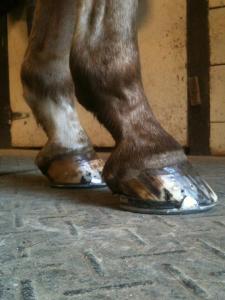Phrases like “shoeing is abusive” or “horses are barefoot in the wild” can easily sway inexperienced horse owners to keep their unsound horses trimmed instead of reaping the benefits of shoeing. Anybody that is any good at anything knows there is never “only 1 way” to do something! Trimming and shoeing horses are no exception.
Techniques used on one horse may not work on another horse. Trimming and shoeing guidelines are developed by professionals with decades of experience. Studies on angles, depth of sole, breakover, flight phase and landing phase are crucial in understanding hoof biomechanics.
Lack of finances could be a reason to pursue keeping a horse barefoot, but barefoot trimming may not be conducive to the horse’s performance. Novice riders that do not have the feel to detect lameness should be aware of the type of footing their barefoot horse is required to work in. Horses may respond differently to variances in footing and riders must become sensitive to the wear and tear they are causing the feet.
On the other hand, more experienced riders might be able to accurately evaluate soundness when the horse is being ridden. They may know what to look for in a quality trim and their horses may do quite well under the right circumstances.
Pros of the Barefoot Trim
The Barefoot horse movement advocates a natural approach to horse care, encouraging lengthy turnout on hard, wet, and uneven ground, to aid in blood circulation within the hoof.
The barefoot approach:
– can be less expensive, with some owners learning to trim their own horse’s feet.
– aims to emulate the hooves of wild horses.
– may allow the horse to confidently move over varied terrain.
– may reduce pain in some Lamanitic or Navicular horses by improving blood circulation in the hoof, promoting a strong elastic frog, and thick heel bulbs.
Now Let’s Be Realistic
The stress put on domesticated horses is in no way natural. The riding horse is routinely asked to run faster, jump higher, and collect deeper, and their bodies must absorb concussion on joints and feet.
The Trim vs Shoe Debate
The value in debating between trimming vs shoeing encourages in depth thought on why a method works. To have a justified opinion, a trimmer or farrier must:
– have worked on hundreds of feet, developing a feel as to what trimming methods work and on what type of horse.
– know their limitations when trimming lame horses. Horses should not be trimmed repeatedly in the same fashion if the lameness persists.
– leave diagnosing lameness to veterinarians.
When Shoes Are The Best Option
Shoes may be the best choice in many different circumstances.
Sole Bruising – simply put, shoes protect the hoof. Period. A horse in work with soft, shelly or thin soles will perform when they are not foot sore. Pads and packing can be added to assist in relieving sole pain and reduce concussion.
Low heels– if one or both hooves have low heels (in comparison to each other or pastern and shoulder angle) the heels can be raised with wedge pads. This is instrumental in achieving balanced movement and equal stride length.
(Note: Not all horses do well by matching hoof angles, especially if the horse is a balanced mover with mismatched angles. If a horse is having lameness or gait issues, matching angles should be the first priority.)
Heel pain– shoes can assist in stabilizing heels for horses that have tendon pain, suspensory pain, or sheared heels. Farriers can create a larger surface area by using larger shoes for horses with small feet or contracted heels. Pads with frog supports can help the hoof “pump” more blood, aiding in healthy blood flow to feet.
Traction– Any horse in competing (beyond beginner levels) on hard, soft, wet or uneven footing will need traction. Traction is applied by the use of road studs, borium, concave shoes (where dirt fills a track at the shoe’s toe area) or caulks. The goal is to only add enough traction to assist the horse; more than needed can cause jarring and excessive concussion. Any traction bigger than a small road stud should be removed after use.
Peer Pressure
Owners love their horses and only want what is best for them. The novice horse owner may be pressured by other horse owners to strictly use barefoot trimmers. There are horses that simply cannot stay sound barefoot. Trimming this kind of horse, again and again, using the barefoot method is a waste of money, time, and causes undue stress on the horse.
Educated farriers turn scientific equine podiatry studies into practical application and spend valuable time experimenting with which techniques work and whicht ones need to be altered when the equine has conformation or gait limitations.
The farrier’s role is to understand the science behind the studies and use the information to correctly trim or shoe the horse, allowing for compromise in trim shape and shoe size based on footing and turnout conditions.
Trimming horses today – from pleasure horses to competition horses – takes skill and know-how by practical, educated farriers dedicated to their craft and horses in their care. Horse owners rely on farriers that can trim and shoe with sound hoof care philosophies. There is no place for “one rule fits all” in the trimming and shoeing industry.


